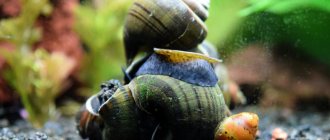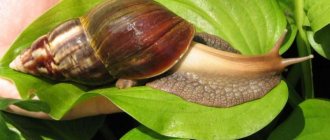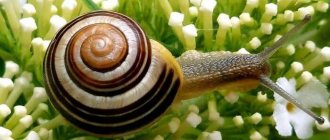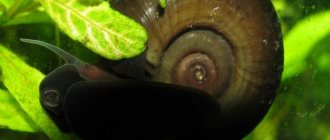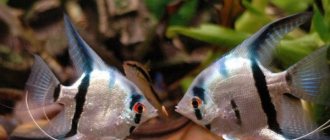The role of aquarium snails
Each aquarium is an artificially created ecosystem in which gastropods play an important role. They do not require additional care and are natural bottom cleaners, eating up rotting plants, leftover fish food, and dead fish. Crawling onto the glass, the snails partially clear it of fouling, but do not eat the green coating entirely, but only gnaw winding paths in it.
On the other hand, the abundance of mollusks is not beneficial: their excrement pollutes the water, they damage the leaves of aquatic plants, and sometimes dig them up entirely (this applies to such large snails as ampullaria), and snails should not be allowed into spawning grounds, since they eat fish eggs.
Feed the giant Achatina vegetables and herbs once a day
Such as cucumber, cabbage and lettuce. Be sure to wash all vegetables and fruits to remove chemicals. Feed in the evening. Remove uneaten food scraps the next day.
- To grow a beautiful and durable shell, the snail needs calcium. These are ground eggshells, food chalk and sepia;
- The snail needs a shallow container of clean water.
The diet of Achatina snails should consist exclusively of food of plant origin. In nature, these snails often eat agricultural crops, various fruit and berry trees, flowers, etc. Next, we will describe in detail useful and prohibited products for Achatina snails.
Products included in a properly balanced snail diet:
- hard-boiled chicken eggs;
- tomatoes;
- bananas;
- sweet bell pepper;
- boiled potatoes;
- dairy products;
- bread;
- greenery;
- berries;
- Champignon;
- dry oatmeal;
- food for aquarium fish.
It is forbidden to feed Achatina snails with the following products:
- sweet pastries;
- pickles;
- smoked meats;
- roast;
- citrus;
- containing alcohol and any alcoholic products.
Ampoules: features of maintenance and breeding
Large and beautiful ampullary snails are very popular among aquarists. These tropical snails, which came into our aquariums from the Amazon basin, are usually brown and bright yellow in color; there are also blue specimens. With good care, ampularia live quite a long time - 3 - 4 years, reaching very significant sizes - the diameter of their shell can be up to 10 centimeters. They are unpretentious, practically omnivorous, and in order to get offspring from them, it is enough to follow some simple rules .
The video shows the appearance of such snails
Where do they live?
Ampoules get along well with any non-aggressive fish. Since these snails grow to significant sizes, it is not recommended to overcrowd the aquarium: approximately 10 liters of water per individual. The water temperature is not particularly important, but if the ampoules get cold, they gather around a heat source, for example, near a heater. If the water in the aquarium is too soft, this affects the appearance of their shell: it becomes covered with depressions, is partially deformed, and grows slowly. In this case, you can add marble chips, pieces of limestone to the water, or simply put sea shells on the bottom. Due to their large size, ampularia quickly pollute the aquarium, so it is advisable to purify the water using a filter and regularly add fresh water.
What do they eat?
Ampularia, like most snails, are omnivorous and voracious. Like all gastropods, the ampularia has a muscular tongue in its mouth, covered with a radula grater, with which it grinds food.
How do they reproduce?
Unlike most snails, ampullaria are dioecious. Since it is almost impossible to distinguish a male from a female, aquarists usually keep 4 to 5 representatives of this species together. They usually become sexually mature at one and a half years and can reproduce all year round. The eggs are formed in the female’s body, and then she lays them above the water level, enveloping the clutch in a mucous cocoon, which hardens in the air. If you want to get offspring, you need to make sure that the eggs do not dry out. To do this, the masonry must be carefully cut off from the glass and placed in a safe place, for example, on a piece of foam plastic that will float on the surface of the water.
The video shows reproduction
In order to get healthy offspring, observe the following conditions:
- The water temperature should be at least 20 degrees. In this case, the eggs will mature in 2–3 weeks;
- you need to monitor the humidity: to prevent the masonry from drying out, it should be periodically sprayed with a spray bottle. If water constantly gets on the eggs, they will become moldy and disappear.
Over time, the masonry darkens: this is the formation of the shells of young snails .
At the appointed time, the young gnaw their way to freedom and descend into the water. The cubs should be fed with chopped greens (duckweed, lettuce), as well as daphnia and cyclops - scalded or dry.
Conditions for reproduction
Most snails are hermaphrodites and do not need special conditions for reproduction. Bisexual snails require two individuals to reproduce. Since it is impossible to determine the sex of the mollusk, you need to buy 4-5 pieces for a guaranteed result.
In the absence of a partner, self-fertilization is possible, but this is quite rare.
If you observe snails, you will notice that they reproduce constantly and in large numbers. You need to find owners for the babies in time, they grow quickly and you can lose control over the number of shellfish in the aquarium.
A snail purchased for growing to a large size should not be mated. After pregnancy, the mother often stops growing. This process also affects the condition of the shell; it flakes and cracks, because the mother snail gives calcium to her offspring.
Preparation
You only need to prepare for the reproduction of ampularia; the rest of the snails are hermaphrodites. Bisexuals do not require special training. If the goal is to obtain offspring, then adult individuals need to be placed in a separate aquarium, then they will immediately, without feeling danger, begin to copulate.
For successful gestation and laying of eggs, favorable conditions must be met:
- the water in the aquarium should be 24-25 degrees;
- avoid changes in water temperature;
- give enough food;
- introduce complementary foods containing calcium.
If the conditions are met, you can hope for the rapid appearance of healthy offspring. It is necessary to plant ampularia only if it is necessary to preserve the offspring. In a community aquarium, most babies will die. And if breeding is not the goal, then ampullaria can reproduce in a general aquarium.
General cleaning of the terrarium can also be an incentive for reproduction.
How do they reproduce?
Same-sex snails reproduce without a partner. One mollusk entering the aquarium is enough, and offspring will be born.
To reproduce heterosexuals, several individuals are needed. Mollusks lay eggs on stones, driftwood, and plant leaves. Species such as melania and helena live in the ground and lay their eggs there.
Ampullaria spawn on the wall or under the lid of the aquarium, above the water level. The female examines the walls and finds a suitable place where she lays eggs. The eggs are large, the process takes about a day. The masonry looks like a bunch of grapes stuck to glass. Three weeks later, the cubs are born and immediately fall into the water.
Care after birth
After the babies go into the water, the aquarium needs to be enriched with oxygen 2 times a day for 20 minutes. Periodically, you need to do a partial water change and promptly remove food debris, dirt and dead snails from the container.
It is unlikely that you will have to remove eggshells from the terrarium, since small snails eat them.
The cubs do not need special feeding. To feed them, crushed fish food and salad greens are quite suitable. There is no need to be afraid of overfeeding; a small ampoule will not eat more than is necessary for growth and development.
Achatina and their features
Many snail lovers keep Achatina at home - land gastropods native to Central Africa. To keep them, it is not necessary to start a terrarium - any aquarium is enough, including a “current” one - because you don’t have to pour water into it.
What do they look like and where do they live?
Achatina is an extremely spectacular animal. With good care, its shell reaches a length of 25–30 cm and a weight of up to 0.5 kg. The color of Achatina largely depends on what they feed on, but generally they have a light gray leg and an amber-brown shell with streaks and stripes. Due to its impressive size, this snail requires a lot of space: each individual should have at least 10 liters.
Suitable primer:
- coconut substrate;
- sawdust;
- peat;
- sand.
Land containing pine filler or flower fertilizers should not be used. The soil is changed as it gets dirty, usually once every two weeks.
In the home for Achatina, it is desirable to maintain a temperature of at least 25 degrees and a sufficiently high humidity, for which the substrate is periodically sprayed with a spray bottle, and a shallow container of water is placed at the bottom.
The aquarium where Achatina lives must be closed with a tightly fitted lid so that the snails do not escape. For ventilation, you need to make holes in the lid or tighten it with a mesh.
What do they eat?
Achatina's main food is fruits and vegetables, cut into thin slices - cucumbers, bananas, carrots, apples, cabbage, etc. It is advisable to diversify the diet of domestic snails, because... they may become accustomed to one type of food and refuse others. Achatina also does not refuse protein foods - pieces of meat or boiled eggs.
Reproduction
Achatina reaches sexual maturity at one year of age and can lay eggs every 2 months. They are hermaphrodites, but self-fertilization occurs infrequently. If the animals are the same size, then cross-fertilization occurs between them, which is preceded by mating games. They do not have specialized reproductive organs, and genetic material is transmitted using calcareous projections, the so-called “cupid's arrows,” that extend from the body near the head. If snails of different sizes participate in reproduction, then the larger animal plays the role of the female, because Carrying eggs requires a lot of energy. Sperm remains in the body of Achatina for up to two years, so the snail, which served as a male, when growing up, can lay eggs, using the old supply of seed that once came from another snail.
The eggs ripen in the snail’s body for about two weeks, and then it lays the eggs in the ground, where they ripen for another 2 to 3 weeks. A clutch, as a rule, contains up to 200 eggs, surrounded by a dense shell, but as the young snail grows, the shell becomes thinner, because the building material of the egg is used to build its shell, and, in the end, the baby is free. You can feed newborn snails the same as adults, only by grinding the food.
What to do with snail clutch
If you find egg laying in the terrarium, take a tablespoon and a plastic bag. Use a spoon to scoop all the eggs into a bag, then put it in the freezer for a few days. Then the bag with eggs can be thrown into the trash.
What to cook from Achatina eggs
From the collected Achatina eggs you can prepare a tasty and unusual dish - snail caviar. In terms of its taste and nutritional qualities, it is not inferior to black caviar, and its unique mushroom aroma will not leave you indifferent. In France, snail caviar is prepared on a special farm, and from there it is exported throughout the world. But you can prepare snail caviar at home, pampering yourself and your loved ones with an exotic delicacy.
Regulation of numbers
Unfortunately, the uncontrolled reproduction of snails creates a threat to the artificial ecological system - an aquarium or terrarium, therefore there are such ways to regulate their numbers as:
- mechanical - young snails can be collected by hand, crushed, and then fed to other snails and predatory fish;
- thermal - eggs and caviar can be frozen, crushed and fed to other snails;
- biological - you can have Helen snails in the aquarium, which will destroy other snails and their eggs.
Chemical and electrical methods of killing snails are more likely to be within the competence of experienced aquarists and will not be considered by us as too risky for amateurs.
3) Snail breeding for business
One of the popular areas is the restaurant business. As we know, certain types of snails are eaten and are an expensive delicacy. Obtaining the required number of snails in the natural environment is not an easy task. Therefore, special “farms” for growing and breeding snails have appeared. To develop such “farms,” a lot of effort had to be made: recreating the climate, an environment close to the natural one, and selecting individuals for reproduction. In an established system, reproduction in snails occurs in a short time, and the number of surviving individuals after reproduction has increased.
Snail diseases
Snails are unpretentious creatures; they tolerate temperature changes, lack of oxygen, and changes in water hardness. However, in some cases, changes in the behavior and appearance of snails force the aquarist to come to their aid. What you should pay attention to?
- Long-term hibernation: the snail closes the shell with a lid and is not active. This may be due to unfavorable conditions: oxygen deficiency, hunger, decreased temperature, etc. Naturally, in this case it is necessary to improve the quality of life of the snail.
- Deformation of the sink can occur both due to high temperature and due to insufficient water hardness. It is not recommended to keep snails at temperatures above 25 degrees and in too soft water. In addition, it is advisable to include lettuce and cabbage in their diet, because... they are rich in calcium.
- Parasites and fungi also sometimes grow on snails. If you notice that the snail is covered with white fouling, place it in a solution of table salt at the rate of 15 g per liter of water for 15 minutes. The snail's health will not be affected, but the parasites will die.
- Mechanical damage. Aggressive fish can greatly annoy snails by trying to bite off pieces of them, so snails should not be kept with predators. Thanks to good regeneration, wounds in snails heal themselves, even damaged eyes are restored. Achatina snails often fall off the walls of their homes and injure their shells, so you need to make sure that they always have soft bedding. If the shell is not severely damaged, it will also heal over time.
With proper care, water snails will serve as a beautiful and useful addition to your aquarium, and Achatina will become the most unpretentious of your pets.
Reproductive system of Achatina snails
Achatina genital organ on the neck
As a rule, Achatina snails reach the peak of their sexual maturation when they are 6 months old. True, a small gap is possible: + month, or – month, but this is more likely due not to the physiology of the mollusks, but to the conditions in which they live and what they eat. It is noteworthy that the snail’s genital organ is located on its… neck. Therefore, if you doubt whether your snail is ready to mate, just examine the neck of the mollusk, there should be a small reproductive organ, which is also called the arrow of love. It looks like a small, light-colored tubercle. So, if you find such a spot on your pet’s neck, don’t be alarmed, this is not a sign of illness at all, but a sign that the snail is ready to give birth.
As for the issue of sexual differences, Akhtina snails belong to the class of hermaphrodites. However, in order for them to give birth, they still need a mate. As for possible cases of self-fertilization, fortunately for us, they are extremely rare, therefore, if you have 1 snail and it will bring you offspring, there is no need to worry. In theory, this shouldn't happen.
The female in a pair is always the larger Achatina, who, moreover, is also older. This fact is explained by the fact that pregnancy is a complex process that requires enormous physical effort on the part of the mollusk, therefore, the strongest individual takes on this task. Although, so you don’t relax, there are cases when both Achatina snails gave birth...
Which Achatina snails cannot be mated?
Sick Achatina snails and close relatives from the same clutch should not be allowed to mate and reproduce; offspring from siblings may have genetic abnormalities and be non-viable. Also, it is worth delaying reproduction if the snail is at the stage of active growth, and its shell also increases in size (as a rule, this happens until the snail is 1 year old). In all these cases, it is better to refuse mating either temporarily or permanently.
